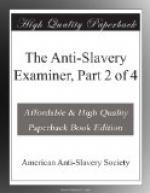FIRST PROPOSITION.—The transition from slavery to freedom is represented as a greet revolution, by which a prodigious change was effected in the condition of the negroes.
In conversation with us, the planters often spoke of the greatness and suddenness of the change. Said Mr. Barnard, of Green Castle estate, “The transition from slavery to freedom, was like passing suddenly out of a dark dungeon into the light of the sun.”
R.B. Eldridge, Esq., a member of the assembly, remarked, that, “There never had been in the history of the world so great and instantaneous a change in the condition of so large a body of people.”
The Honorable Nicholas Nugent, speaker of the house of assembly, and proprietor, said, “There never was so sudden a transition from one state to another, by so large a body of people. When the clock began to strike the hour of twelve on the last night of July, 1834, the negroes of Antigua were slaves—when it ceased they were all freemen! It was a stupendous change,” he said, “and it was one of the sublimest spectacles ever witnessed, to see the subjects of the change engaged at the very moment it occurred, in worshipping God.”
These, and very many similar ones, were the spontaneous expressions of men who had long contended against the change of which they spoke.
It is exceedingly difficult to make slaveholders see that there is any material difference between slavery and freedom; but when they have once renounced slavery, they will magnify this distinction more than any other class of men.
SECOND PROPOSITION.—Emancipation in Antigua was the result of political and pecuniary considerations merely.
Abolition was seen to be inevitable, and there were but two courses left to the colonists—to adopt the apprenticeship system, or immediate emancipation. Motives of convenience led them to choose the latter. Considerations of general philanthropy, of human rights, and of the sinfulness of slavery, were scarcely so much as thought of.
Some time previous to the abolition of slavery, a meeting of the influential men of the island was called in St. John’s, to memorialize parliament against the measure of abolition. When the meeting convened, the Hon. Samuel O. Baijer, who had been the champion of the opposition, was called upon to propose a plan of procedure. To the consternation of the pro-slavery meeting, their leader arose and spoke to the following effect:—“Gentlemen, my previous sentiments on this subject are well known to you all; be not surprised to learn that they have undergone an entire change, I have not altered my views without mature deliberation. I have been making calculations with regard to the probable results of emancipation, and I have ascertained beyond a doubt, that I can cultivate my estate at least one third cheaper by free labor than by slave labor.” After Mr. B. had finished his remarks, Mr. S. Shands, member of assembly, and a wealthy proprietor, observed that he entertained precisely the same views with those just expressed; but he thought that the honorable gentleman had been unwise in uttering them in so public a manner; “for,” said he, “should these sentiments reach the ear of parliament, as coming from us, it might induce them to withhold the compensation.”




